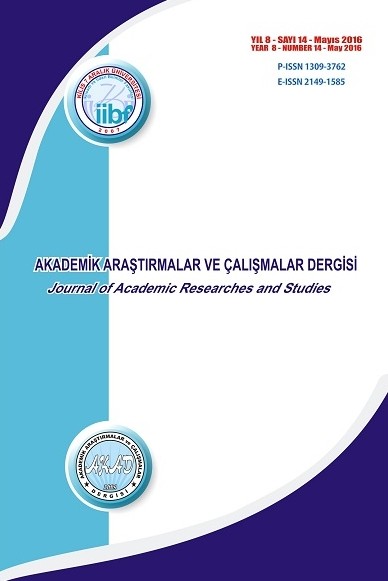Döviz Piyasalarındaki Simetrik ve Asimetrik Nedensellik İlişkisi
Döviz, Toda-Yamamoto Nedensellik, Hatemi-J Asimetrik Nedensellik
Symmetric and Asymmetric Causality Relationship in Foreign Exchange Markets
___
- Asimakopoulos, I., Ayling, D., & Mansor Mahmood, W. M. (2000). Non-linear granger causality in the currency futures returns. Economics Letters 68, 25-30. https://doi.org/10.1016/S0165-1765(00)00219-6
- AuYong, H. H., Gan, C., & Treepongkaruna, S. (2004). Cointegration and causality in the Asian and emerging foreign exchange markets: Evidence from the 1990s Financial Crises. International Review of Financial Analysis, 13, 479-515. https://doi.org/10.1016/j.irfa.2004.02.024
- Bekiros, S., & Marcellino, M. (2013). The multiscale causal dynamics of foreign exchange markets. Journal of International Money and Finance 33, 282-305. https://doi.org/10.1016/j.jimonfin.2012.11.016
- Berke, B., Özcan, B., & Dizdarlar, H. I. (2014). Döviz piyasasının etkinliği: Türkiye için bir analiz. Ege Akademik Bakış, 14(4), 621-636. https://dergipark.org.tr/tr/download/article-file/560334
- Bohdalova, M., & Gregus, M. (2014). Cointegration analysis of the foreign exchange rate pairs. CBU International Conference on Innovation, Technology Transfer and Education, 147-153. https://doi.org/10.12955/cbup.v2.497
- Carrion-i Silvestre, J. L., Kim, D., & Perron, P. (2009). GLS-based unit root tests with multiple structural breaks under both the null and the alternative hypotheses. Econometric Theory, 25, 1754-1792. https://doi.org/10.1017/S0266466609990326
- Cremaschini, A. (2019). A cointegration analysis across exchange rates of international currencies in the euro era. https://doi.org/10.13140/RG.2.2.16533.78562
- Çepni, E. (2014). Ekonomik göstergeler ve istatistikler rehberi (6. Baskı). Seçkin Yayınevi, 1-271. https://www.seckin.com.tr/kitap/n/994529776/title/ekonomik-gostergeler-ve-istatistikler-rehberi-elif-cepni.html
- Çiçek, B. (2014). A cointegration test for Turkish foreign exchange market efficiency. Asian Economic and Financial Review, 4(4), 451-471. https://archive.aessweb.com/index.php/5002/article/view/1171
- Ferre, M., & Hall, S. G. (2002). Foreign exchange market efficiency and cointegration. Applied Financial Economics, 12(2), 131-139. https://doi.org/10.1080/09603100110090055
- Güriş, S., & Büyükmumcu, B. (2015). Denge reel döviz kuru tahmininde NATREX modeli: Türkiye uygulaması. Social Sciences Research Journal, 4(2), 76-95. https://dergipark.org.tr/tr/pub/ssrj/issue/22479/240449
- Hatemi-J, A. (2012). Asymmetric causality tests with an application. Empirical Economics, 43(1), 447-456. https://doi.org/10.1007/s00181-011-0484-x
- Kang, H. (2008). The cointegration relationships among G-7 foreign exchange rates. International Review of Financial Analysis 17, 446-460. https://doi.org/10.1016/j.irfa.2007.01.004
- Kumar, A. (2015). Impact of currency futures on volatility in exchange rate: A study of Indian currency market. SAGE Publications, 19(1), 95-108. https://doi.org/10.1177/0971890715585204
- Kühl, M. (2007). Cointegration in the foreign exchange market and market efficiency since the introduction of the Euro: Evidence based on bivariate cointegration analyses. Center for European, Governance and Economic Development Research 68, 1-33. https://www.researchgate.net/publication/5081301_Cointegration_in_the_Foreign_Exchange_Market_and_Market_Efficiency_since_the_Introduction_of_the_Euro_Evidence_based_on_bivariate_Cointegration_Analyses
- Le, T., Martin, F., & Nguyen, D. (2018). Dynamic connectedness of global currencies: A conditional granger-causality approach, Center for Research in Economics and Management Working Paper, 1-44. https://hal.archives-ouvertes.fr/hal-01806733
- Maki, D. (2012). Tests for cointegration allowing for an unknown number of breaks. Economic Modelling, 29(5), 2011-2015. https://doi.org/10.1016/j.econmod.2012.04.022
- Müslümov, A., Hasanov, M., & Özyıldırım, C. (2002). Döviz kuru sistemleri ve Türkiye’de uygulanan döviz kuru sistemlerinin ekonomiye etkileri. TÜGDAD Ekonomi Ödülleri, http://www.tugiad.org.tr/tugiad.php?sayfa=ekonomi&kategori=3&all=1.
- Odabaşı, Y. (2011). Döviz kuru volatilitesinin ihracat üzerindeki etkisi ve ileriye dönük volatilite tahmini: Türkiye için bir uygulama (Yayın No. 288169) [Doktora tezi, Dumlupınar Üniversitesi] Yüksek Öğretim Kurumu Tez Merkezi. https://tez.yok.gov.tr/UlusalTezMerkezi/tezSorguSonucYeni.jsp
- Polat, F. Y. (2015). Döviz kurları, ülke ekonomisi için önemi ve kur savaşları (Yayın No. 423275) [Yüksek lisans tezi, Hitit Üniversitesi] Yüksek Öğretim Kurumu Tez Merkezi. https://tez.yok.gov.tr/UlusalTezMerkezi/tezSorguSonucYeni.jsp
- Sadhwani, R. (2020). Cointegration analysis of selected currency pairs traded in Indian foreign exchange market. International Journal of Management, 11(5), https://doi.org/10.34218/IJM.11.5.2020.045476-485.
- Toda, H. Y., & Yamamoto, T. (1995). Statistical inference in vector autoregressions with possibly integrated processes. Journal of Econometrics, 66(1-2), 225-250. https://doi.org/10.1016/0304-4076(94)01616-8
- Türkiye Cumhuriyet Merkez Bankası. Elektronik veri dağıtım sistemi. https://evds2.tcmb.gov.tr/
- Ünsal, E. M. (2005). Uluslararası iktisat teori, politika ve açık ekonomi makro iktisadı, İmaj Yayıncılık. https://www.nadirkitap.com/uluslararasi-iktisat-teori-politika-ve-acik-ekonomi-makro-iktisadi-erdal-m-unsal-kitap17803482.html
- ISSN: 1309-3762
- Yayın Aralığı: Yılda 2 Sayı
- Başlangıç: 2009
- Yayıncı: Kilis 7 Aralık Üniversitesi
Enerji Tüketimi ve Ekonomik Büyüme İlişkisine Ekonometrik Yaklaşım
Elif YILMAZ, Pelin PASİN COWLEY
Dijital Liderliğin Yenilikçi İş Davranışı ve İş Performansı Üzerine Etkisi
Döviz Piyasalarındaki Simetrik ve Asimetrik Nedensellik İlişkisi
Nazlıgül GÜLCAN, Arife ÖZDEMİR HÖL
İhracat Ürün Çeşitlendirmesinin Ekolojik Ayak İzi Üzerindeki Etkisi
İş Tatmininin Örgütsel Bağlılık Üzerindeki Etkisinde Liderlik Tarzlarının Aracılık Rolü
Takım Dayanıklılığı/Rezilyansı Araştırmalarının Bibliyometrik Analizi
Banka Kredi Kanalı Faiz Kanalını Güçlendiriyor mu? Türkiye Üzerine SVAR Analizi
Türkiye’de Farklı Parasal Göstergeler ve İstihdam Değişimlerinin Ekonomik Büyümeye Etkisi
Çevresel Kuznets Eğrisi Hipotezinin Geçerliliği: Türkiye Üzerine Ampirik Bir Çalışma
